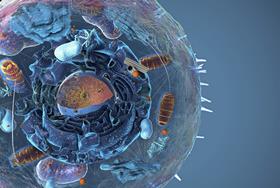
I’m very proud – and always have been – of the advances that have been made in medicinal chemistry and drug discovery. Tremendous amounts of work (and tremendous amounts of public and private investment) have led us to all sorts of discoveries that have made a real difference in the lives of sick patients, and I am very glad indeed to have been a part of that effort for the last 35 years (and counting!)
But pride shouldn’t make us unwilling to admit those areas where our knowledge thins out and disappears. There are several very large, very important blind spots in drug discovery that I hope can be illuminated. In no particular order, I would list:
Where’d it go?
Our lack of knowledge about where our compounds go inside living cells. We know a fair amount about drug distribution and clearance in whole animals and in whole human patients (although still not enough). But intracellular distribution is usually a black box. Cells are tremendously complex spaces, full of distinct regions and structures, each with their own constantly-changing environment. Drug molecules are naturally unevenly partitioned over this landscape, and this has a significant influence on their actions (for better and for worse). In some cases we can actually see them (if a molecule happens to be intrinsically fluorescent or can easily be labelled), and such experiments make it clear that there are myriad different ways that compounds can congregate in or be excluded from particular cellular locations. We need much more sensitive ways of gathering such data, with much higher resolution in both space and in time. And that leads to…
Breaking down barriers
Our difficulty in predicting which molecules will cross cellular membranes in the first place. To be sure, we have some rules of thumb, assays and computational tools to help with this question. But even with these, we get surprised in both directions: compounds that don’t look like they would be very permeable turn out to be fine, and ones that look, in turn, as if they should be fine, struggle to be absorbed or to reach cell interiors. A lot of this is down to the complex mechanisms by which molecules are ferried through the various membranes, but even passive permeation (just soaking through) can be rather mysterious at times. There’s the gut wall, the cells lining the capillaries (and the special ones in the brain), and then the cell membranes themselves in your target tissues. All of them have important similarities and equally important differences, and we really need to understand them more.
Toxic surprise
The never-ending problem of being surprised by toxicity. This is perhaps a subset of not knowing how many sites are binding our drug compounds in living systems in general. We run assays to try to get an idea, but there are thousands upon thousands of potential binding sites out there, and we have absolutely no way to test them all up front. Some of these are going to be innocuous cubbyholes, and some of them can actually be part of the beneficial multi-system effects that are an occasional bonus. But others are bad news, waiting to ambush us deep in clinical trials (or worse, out in the broader market population after regulatory approval). All too often, we have no idea that it’s coming. The other side of toxicity is efficacy, though, and there we run into…
Hitting the wrong target
Our inabiilty to be sure that we are going after the right targets in the first place. This is a significant part of the industry’s notorious 85% failure rate in human trials (and most of the rest is due to the just-discussed toxicity problem). We simply don’t know enough about the molecular and cellular biology of health and disease. We take our best shots at particular targets, each one part of a pathway that we have reason to believe will affect our disease of interest. But we are wrong about these ideas a lot. Constantly. Either the target turns out not to do what we thought – or even if it does, it may be nowhere near as important as we imagined (or is compensated for by some other pathway entirely). Improvements here would be wonderful, but it’s hard to be optimistic about any general solutions, given the nature of disease itself.
There you have it! Unbelievable improvements in human health (and, it must be said, unbelievable monetary rewards) are waiting. Anyone who can make significant headway on these problems should go ahead and sit for the sculptors, because they will deserve the statuary.
